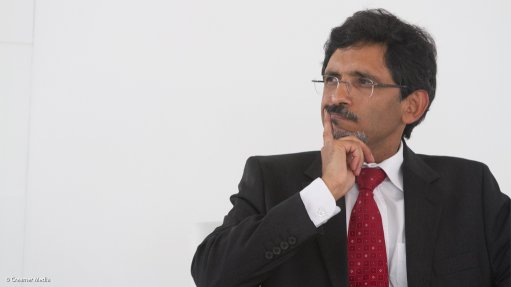
Economic Development Minister Ebrahim Patel
Photo by: Duane Daws
With the expansive development of infrastructure keeping South Africa above the recessionary threshold, Economic Development Minister Ebrahim Patel on Tuesday said more major projects would be announced soon as government aimed to maintain the “extraordinary spending” undertaken in “tough times”.
South Africa had spent some R290-billion last year – more than R1-billion every working day – on infrastructure projects, and more was to come as government planned to unpack major new infrastructure projects this year.
Speaking at a post-State of the Nation Address Economic Sectors, Employment and Infrastructure Development Cluster briefing, in Pretoria, Patel said, despite being in a period of immense economic pressure, it maintained an “extraordinary amount” of spending on infrastructure to stabilise the economy.
“That’s [one of the reasons] why [South Africa] hasn’t gone into a recession,” he said, pointing to the unfavourable global economic context in which the nation found itself.
The country was confronted with headwinds that could slow progress, including a volatile global economy with lower growth, countries in recession and lower demand for platinum and iron-ore and gold production falling while the “deepest and most devastating” drought was also being experienced in “many generations”.
However, last year, some 160 new schools, 29 medical clinics, one hospital and 100 000 houses were built; 265 000 homes were connected to electricity; new higher education hostel accommodation for 3 100 students had been provided; 1 700 MW had been connected to the national grid – almost equal the capacity of the Koeberg power station – and ten new renewable-energy plants were built.
This was in addition to starting construction on three new technical college campuses and two new universities, the erection of more than 300 km of transmission lines, the upgrade or repair of 24 000 km of roads and the start of the development of a modern urban public transport system, besides others, Patel noted.
The scale-up of the infrastructure programme was a high priority, with Patel announcing in February the fast-tracking of 20 infrastructure projects identified by Cabinet and bringing a number of them to construction within the next 6 to 15 months.
This included the Clanwilliam and Mzimvubu dams; the new N2 Wild Coast highway from East London to eThekwini; a large water pipeline to the Lephalale/Waterberg area; the N3 De Beers pass and 28 additional renewable-energy plants.
“We have done work on the design of these projects, making good progress on establishing the technical specifications and engineering requirements, securing part-funding, approving environmental assessments and inviting contractors to bid for the projects,” he said.
Much work had been done on several other projects, including water-use permits and feasibility studies, with more information to be released publicly in due course.
Meanwhile, work continued on the expansion and modernisation of port capacity across the country’s coastline, with some of the major ports and harbours already undergoing some construction to put in place infrastructure to attract and support manufacturing operations and facilitate the efficient operation of the ports.
Further, some R40-million had been set aside to roll out free WiFi in metropolitans Tshwane, Ekurhuleni, Nelson Mandela Bay, Mangaung, Cape Town and Johannesburg.
In addition, talks were under way with a Chinese consortium to invest $3.9-billion within the Musina Special Economic Zone for metallurgical technology, processing, steel plant and mine construction, and energy, to advance beneficiation and add value to the country’s mineral wealth.
Infrastructure funding had been approved for the development of a 1.8 MW hydrogen fuel cell, with government engaging leading fuel cell original-equipment manufacturers to establish manufacturing facilities in South Africa.
Investment in gas infrastructure started, with 14 licences issued for oil and gas exploration, while the drilling of two exploration wells for potential oil and gas finds would take place along the South African coast.